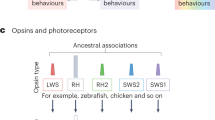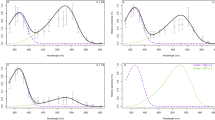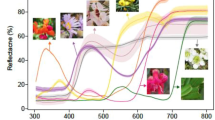Abstract
Most mammals, with the exception of primates, have dichromatic vision and correspondingly limited colour perception1. Ultraviolet vision was discovered in mammals only a decade ago2, and in the few rodents and marsupials where it has been found, ultraviolet light is detected by an independent photoreceptor2,3. Bats orient primarily by echolocation, but they also use vision. Here we show that a phyllostomid flower bat, Glossophaga soricina, is colour-blind but sensitive to ultraviolet light down to a wavelength of 310 nm. Behavioural experiments revealed a spectral-sensitivity function with maxima at 510 nm (green) and above 365 nm (ultraviolet). A test for colour vision was negative. Chromatic adaptation had the same threshold-elevating effects on ultraviolet and visible test lights, indicating that the same photoreceptor is responsible for both response peaks (ultraviolet and green). Thus, excitation of the β-band of the visual pigment is the most likely cause of ultraviolet sensitivity. This is a mechanism for ultraviolet vision that has not previously been demonstrated in intact mammalian visual systems.
This is a preview of subscription content, access via your institution
Access options
Subscribe to this journal
Receive 51 print issues and online access
$199.00 per year
only $3.90 per issue
Buy this article
- Purchase on Springer Link
- Instant access to full article PDF
Prices may be subject to local taxes which are calculated during checkout



Similar content being viewed by others
References
Jacobs, G. H. The distribution and nature of colour vision among the mammals. Biol. Rev. 68, 413–471 (1993)
Jacobs, G. H., Neitz, J. & Deegan, J. F. II Retinal receptors in rodents maximally sensitive to ultraviolet light. Nature 353, 655–656 (1991)
Jacobs, G. H. & Deegan, J. F. II Sensitivity to ultraviolet light in the gerbil (Meriones unguiculatus): Characteristics and mechanisms. Vision Res. 34, 1433–1441 (1994)
Suthers, R., Chase, J. & Braford, B. Visual form discrimination by echolocating bats. Biol. Bull. 137, 535–546 (1969)
Chase, J. Differential responses to visual and acoustic cues during escape in the bat Anoura geoffroyi: cue preferences and behavior. Anim. Behav. 31, 526–531 (1983)
Winter, Y. Flight speed and body mass of nectar-feeding bats (Glossophaginae) during foraging. J. Exp. Biol. 202, 1917–1930 (1999)
Biedinger, N. & Barthlott, W. Untersuchungen zur Ultraviolettreflexion von Angiospermenblüten. I. Monocotyledoneae. Trop. Subtrop. Pflanzenwelt 86, 1–122 (1993)
Neumeyer, C. Das Farbensehen des Goldfisches (Georg Thieme, Stuttgart, New York, 1988)
Kirschfeld, K. Carotenoid pigments: their possible role in protecting against photooxidation in eyes and photoreceptor cells. Proc. R. Soc. Lond. B 216, 71–82 (1982)
von Campenhausen, C. Photoreceptors, lightness constancy and color vision. Naturwissenschaften 73, 674–675 (1986)
Dyer, A. G. Broad spectral sensitivities in the honeybee's photoreceptors limit color constancy. J. Comp. Physiol. A 185, 445–453 (1999)
Arrese, C. A., Hart, N. S., Thomas, N. M., Beazley, L. D. & Shand, J. Trichromacy in Australian marsupials. Curr. Biol. 12, 657–680 (2002)
Remy, M. & Emmerton, J. Behavioral spectral sensitivities of different retinal areas in pigeons. Behav. Neurosci. 103, 107–177 (1989)
Smith, H. Light quality, photoperception and plant strategy. Annu. Rev. Plant Physiol. 33, 481–518 (1982)
Jacobs, G. H. Ultraviolet vision in vertebrates. Am. Zool. 32, 544–554 (1992)
Morton, R. A. in Handbook of Sensory Physiology VII/I (ed. Dartnall, H. J. A.) 33–68 (Springer, Berlin, 1972)
Douglas, R. H. & Marshall, N. J. in Adaptive Mechanisms in the Ecology of Vision (eds Archer, S. N., Djamgoz, M. B. A., Loew, E. R., Partridge, J. C. & Vallerga, S.) 95–162 (Kluwer, New York, 1999)
Griswold, S. M. & Stark, W. S. Scotopic spectral sensitivity of phakic and aphakic observers extending into the near ultraviolet. Vision Res. 32, 1739–1743 (1992)
Govardovskii, V. I., Fyhrquist, N., Reuter, T., Kuzmin, D. G. & Donner, K. In search of the visual pigment template. Vis. Neurosci. 17, 509–528 (2000)
Acknowledgements
We thank C. Peppermüller and H. Sadowski for stimulus calibrations, and G. Seitz for general support. This work was supported by a grant from the Volkswagen Foundation to Y.W. J.E.L. was supported by the German Academic Exchange Service (DAAD).
Author information
Authors and Affiliations
Corresponding author
Ethics declarations
Competing interests
The authors declare that they have no competing financial interests.
Rights and permissions
About this article
Cite this article
Winter, Y., López, J. & von Helversen, O. Ultraviolet vision in a bat. Nature 425, 612–614 (2003). https://doi.org/10.1038/nature01971
Received:
Accepted:
Issue Date:
DOI: https://doi.org/10.1038/nature01971
This article is cited by
-
Intermediary floral traits between natural hybrid and its parents in the Xiquexique (Cactaceae)
Organisms Diversity & Evolution (2024)
-
Counteracting forces of introgressive hybridization and interspecific competition shape the morphological traits of cryptic Iberian Eptesicus bats
Scientific Reports (2022)
-
Bats seek refuge in cluttered environment when exposed to white and red lights at night
Movement Ecology (2021)
-
Retention and losses of ultraviolet-sensitive visual pigments in bats
Scientific Reports (2018)
-
Auditory opportunity and visual constraint enabled the evolution of echolocation in bats
Nature Communications (2018)
Comments
By submitting a comment you agree to abide by our Terms and Community Guidelines. If you find something abusive or that does not comply with our terms or guidelines please flag it as inappropriate.



